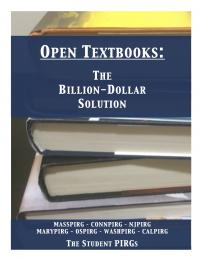 Report by Ethan Senack for the Student PIRGs
Report by Ethan Senack for the Student PIRGs
Full report here, (CC-BY)
Executive Summary:
According to the College Board, the average undergraduate student should budget between $1,200 and $1,300 for textbooks and supplies each year. That’s as much as 40% of tuition at a two-year community college and 13% at a four-year public institution.
For many students and families already struggling to afford a college degree, that is simply too much – meaning more debt, working longer hours, or making choices that undermine academic success.
Unfortunately, even the proliferation of cost-saving options like used books, textbook rental programs, and e-textbooks is not enough to solve the problem. Publishers undermine these markets by releasing new editions, bundling in single-use pass codes, or including use restrictions. Even more problematic, the price of these textbook options is still determined by the ever-increasing price of a new, printed textbook.
In order to reduce costs for students now, and in the future, we must break free from the traditional textbook market and deliver educational materials through an alternative model.
This report analyzes the potential of open textbooks and open licensing to become that alternative.
In brief, open textbooks are faculty-written, peer-reviewed textbooks that are published under an open license – meaning that they are available free online, they are free to download, and print copies are available at $10-40, or approximately the cost of printing.
This report reviews data collected from five different campus-based pilot programs that encouraged faculty to replace the traditional textbook for their course with openly licensed educational resources (OER) and open textbooks.
Findings:
Analysis of these pilots determines that a student saves $128 per course, when their traditionally published textbook is replaced with an open textbook.
By extrapolating average student savings and applying it to larger segments of the student population, we can predict that open textbooks have the potential to save more than a billion dollars each year.
Additionally, by comparing total investment and money spent during these pilots with the total savings by students as a result of the project, we can conclude that investing in open textbooks has an exponential return on investment in student savings.
Recommendation:
Institutions and all stakeholders in higher education should take greater ownership over solving the problem of high textbook prices, and can do so effectively by providing the training and resources faculty need to convert their classroom to an open textbook.




